If you want to legally protect your goods and services by registering them under the trademark Act of 1999, but are unsure how to do so, you've come to the right place!
Recent Update
The World Intellectual Property Organization (WIPO) has announced the latest update to the Nice Classification, which will be available from 1 January 2023. If you are applying for international trademark registration on or after this date, it is important to specify protection using the latest edition of the Nice Classification. Trademark Class Search: Here are some key points to keep in mind:
- Changes in the Twelfth Edition: The new edition of the Nice Classification has introduced several changes compared to the previous edition
- Transition period practice: WIPO has informed the Offices of the Contracting Parties and applicants about the practice followed by the International Bureau of WIPO during the transition to the twelfth edition of the Nice Classification. This ensures consistency and clarity in the examination of applications for international registration.
What Is Trademark Class?
If you wish to safeguard your company name, logo, or concept, you must file a trademark application with the patent and trademark office. However, you must also decide which group of products or services your trademark will cover. It is best to conduct a trademark class search before an international filing.
The types of goods or services that consumers want to use trademark protection to protect are the basis for a trademark class list. There are now 45 trademark classes in India, as per the Trademark Act of 1999. These TM classes make it possible for users to expedite the registration of the mark and prevent future trademark challenges.
Understanding Trademark Classes
- The categories of goods and services for which trademarks may be registered are known as trademark classes list
- There are 45 trademark classes, divided into two main categories: Goods, products, and services
- Goods and products are classified into 34 different trademark classes, while services are classified into 11 different classes
- The classification system is designed to make it easy for trademark examiners to determine whether a particular trademark is already in use or conflicts with an existing trademark in the same class
- A single good or service may fit into more than one category
- Understanding trademark classes is important when applying for trademark registration, as it can help ensure that you are applying for protection in the correct class or classes
- By carefully selecting the correct classes for your goods or services, you can help ensure that your trademark is registered and protected properly.
Why Choose TM Class?
- All commodities and services are separated into 45 classes under the TM class list with 34 classes for goods and 11 classes for services
- Each class has a different set of products or services, yet the class name may not always make this clear
- The two categories of goods and services are never combined
- You must choose the category of products or services that your trademark will cover when you submit your trademark application
- The products, services, and classes that you specify in your application are the only things that your trademark will cover
- You must submit a separate trademark application for each new commodity or service you add if they fall under a different class.
How to Find Trademark Classes?
You can follow these tips to find the trademark class required:
- Determine the type of goods or services your trademark will be used for
- Consult the Nice Classification system, which divides products and services into 45 classes
- Review the list of classes to find the ones that are relevant to your goods or services
- Pick the appropriate subclass inside each applicable class that best fits your products or services
- Consider seeking legal advice to ensure that you have correctly identified the appropriate class and subclass for your trademark
- Include the identified class and subclass information in your trademark application to ensure that it is properly classified and protected.
When Trademark Is Not Infringed
- Using a different mark
- Using the trademark for different goods or services than those covered by the owner’s registration
- Using the trademark for commentary, criticism, news reporting, or other similar purposes, which may be considered fair use
- Having consent from the trademark owner to use the mark
- Using the trademark to describe the product or service rather than as a source identifier
- The trademark owner has abandoned or not used the mark for a significant period of time, making it unenforceable against the alleged infringer.
Why Is Trademark Class Essential For Your Business?
A trademark is what makes you stand out from the competition and makes it simple for customers to locate you.
The use of trademarks promotes business expansion through social media and enhances product traffic and brand identification. Trademarks are regarded as valuable assets.
Benefits Of Registering A Trademark
It has many advantages such as
- Brand protection is offered by trademark registration.
- Avoiding confusing trademarks.
- Also, this law ensures that the owner receives greater benefits.
- It helps the owner in granting this trademark worldwide.
- Once a trademark is registered, its owner is legally recognized as the mark’s owner.
- After trademark registration, the owner has the legal right to prosecute anybody who uses the symbol without permission or in violation of trademark law.
- It is common knowledge that an unregistered trademark will never be used by the public.
- It is the simplest and least expensive approach to registering your logo.
- A registered trademark can express the mission, caliber, and distinctive features of your product.
- A registered trademark has the ability to be sold, assigned, or even franchised.
- Young minds are drawn to big brands and can be drawn to them like a magnet.
What Are Listed 35 TM Classes
-
Trademark Class Details
A trademark is a kind of intellectual property right (IPR) that grants the holder the sole right to use a certain design, name, logo, term, or phrase. Establishing a brand for your company requires trademark registration. Some of the advantages of trademark classes are given below:
-
- A registered trademark offers a brand a distinct identity and enables its owner to identify it
- Different categories of goods and services can be categorised using trademarks
- Registering a trademark under a specific class provides benefits such as full rights to the mark and brand development
- To maximise the benefits of the trademark, it is also crucial to grasp what it means.
-
Trademark Definition
A trademark can be a term, name, logo, or combination registered as a trademark, the owner is granted monopoly rights over it.
-
- The success and branding of a firm depend on trademark registration
- Without a trademark, other people could take advantage of a business and cause problems
- The name, symbol, and emblem of a corporation are all protected by a valid trademark
- TM classes are divisions that assist in classifying various goods and services
- Trademark classes are important to know when registering a trademark.
What Is the Concept of Trademark Classes?
- With trademark protection, TM classes aid in protecting goods or services
- In India, there are 45 TM classes based on the type of commodity or service
- Using the right trademark class helps avoid trademark objections and makes registration easier
- The remaining classes are for services, leaving only 34 for products
- Every class includes a broad range of products and services
- Candidates can choose the class that includes their products or services
- They must submit form TM-1 to enrol in one class
- They must file form TM-1 to register a collective trademark.
What Conditions Are Vital for Trademark Protection?
When you make a trademark, it should be different from others, so it’s easily known and remembered. It can’t be a normal or basic word, or too similar to another trademark in the same field. You need to use it for buying or telling people about things you’re selling. It can’t be mean or hurtful, and it can’t just describe what you’re selling. Finally, it should be able to be listed with the right people who keep track of trademarks.
How Do You Pick the Best Trademark?
When registering a trademark, it’s important to pick the appropriate class and words. Here are some of the tips to pick the best trademark:
- Only the products and/or services that you list in your application will be covered by your trademark
- You cannot add more goods or services after submitting your application
- If you want to use your trademark on clothing, footwear, or headgear, choose Class 25
- If you want to sell other people’s products using your trademark, choose class 35 and select the term retail services for clothing.
Trademark Class List for Goods
| S.no | Classes | Explanation |
| 1 | Trademark class 1 | Chemicals are employed in a variety of industries, including forestry, artificial resin production, tanning, and glue production. |
| 2 | Trademark Class 2 | Paintings, mordants, pigments made of coal and other materials, printing, lacquers, and other forms of art. |
| 3 | Trademark class 3 | Products for cleaning, laundry, bleach, abrasives, cosmetics, essential oils, etc. |
| 4 | Trademark class 4 | Fuels, greases, wetting and binding substances, illumination, wicks, industrial oil, etc. |
| 5 | Trademark class 5 | Medications, pesticides, herbicides, veterinary products, sanitizers, dietetics, dental wax, etc. |
| 6 | Trademark class 6 | Castings made of metal, common metal and its alloys, locks and safes, hardware, metal for use in construction, other metals not included in any other class, etc. |
| 7 | Trademark class 7 | Egg incubators, machine parts, and machinery (apart from land vehicles). |
| 8 | Trademark class 8 | Cash registers, educational tools, calculators, magnetic data storage devices, and other data processing equipment |
| 9 | Trademark class 9 | Cash registers, educational tools, calculators, magnetic data storage devices, and other data processing equipment |
| 10 | Trademark class 10 | Surgical, prosthetic limbs, dental and medical equipment, eyes, teeth, etc. |
| 11 | Trademark class 11 | Whatever personal or social services fall under this category. People are watched after to ensure their wellbeing and safety. Services such as weddings and burials are provided. This class excludes any services that fall within classes 35, 36, 39, 41, 42, or 44 as well as any car rental services. |
| 12 | Trademark class 12 | Equipment for cooking, dying, heating, cooling, steam generation, lighting, etc. |
| 13 | Trademark class 13 | Fireworks, weapons, explosives, ammunition, etc. |
| 14 | Trademark class 14 | Jewelry, items made of precious metals, and other merchandise are available. |
| 15 | Trademark class 15 | Instruments of music, etc. |
| 16 | Trademark class 16 | Printing blocks, bookbinding, printed matter, paintbrushes, and products produced from cardboard, playing cards, and paper, as well as products made from these materials. |
| 17 | Trademark class 17 | Asbestos, gum, mica, rubber, and products produced from these materials that aren’t classified under another category. |
| 18 | Trademark class 18 | Animal hides, skins, leather, imitation leather, and objects derived from these materials that are not classified under other groups, etc. |
| 19 | Trademark class 19 | Stiff non-metallic pipes for bitumen, pitch, asphalt, and other materials. |
| 20 | Trademark class 20 | Picture frames, wood furniture, mirrors, reed, cork, and cane are all separate categories. |
| 21 | Trademark class 21 | Utensils for the home and kitchen, cleaning supplies, materials for manufacturing brushes, etc. |
| 22 | Trademark class 22 | Sacks and bags, ropes, sails, strings, and other fibrous textiles. |
| 23 | Trademark class 23 | Yams and threads for use in textiles. |
| 24 | Trademark class 24 | The other classes do not include textiles or textile-related products. |
| 25 | Trademark class 25 | Footwear, clothing, and headgear. |
| 26 | Trademark class 26, 27 | For floor coverings, people employ non-textile carpet, linoleum, rugs, wall hangings, and other things. |
| 27 | Trademark class 28 | Decorations for Christmas. Games, toys, and other sporting goods that don’t fall under another class. |
| 28 | Trademark class 29 | Jams, oils, edible oils, poultry products, eggs, etc. |
| 29 | Trademark class 30 | Spices, rice, sugar, cocoa, coffee, tapioca, etc. |
| 30 | Trademark class 31 | Fresh produce, seeds, malt, and so on. There is no other class for horticulture, agriculture, or forestry grains. |
| 31 | Trademark class 32 | Aerated beverages, beer, non-alcoholic beverages (such as juices and fruit drinks), and other ingredients used in beverage preparation. |
| 32 | Trademark class 33 | All alcoholic drinks (beer not included) |
| 33 | Trademark class 34 | Tobacco, matches, and smoking accessories |
Trademark Class List for Services
| S.no | Class | Explanation |
| 1 | Trademark class 35 | This category contains marketing and business services that help management run the company’s (a commercial organisation) activities. The phrase refers to any activity in which a general public statement is made or in which any kind of goods or services are discussed. |
| 2 | Trademark class 36 | Activities related to insurance, finance, or the financial industry are included in this class. |
| 3 | Trademark class 37 | It covers all work done by contractors and subcontractors that are involved in the construction, maintenance, or restoration of buildings. |
| 4 | Trademark class 38 | Services that help people communicate verbally or visually are covered in this class. |
| 5 | Trademark class 39 | Any service that involves keeping items at a warehouse or another location or moving them from one location to other falls under this category. Air, land, or sea can all be used to deliver these services. |
| 6 | Trademark class 40 | This class includes any service that modifies the chemical or mechanical makeup of a substance. Any additional service that does not fall under another category may also be included in this. |
| 7 | Trademark class 41 | This includes any products or services that increase a person’s or an animal’s knowledge or cognitive ability. This category also includes entertainment services. |
| 8 | Trademark class 42 | Anything pertaining to science, technology, or the creation of computer hardware, software, or legal services. This area includes engineering services for medical services (design, blueprints, etc.). Business research services do not fall under class 35, class 36, class 37, or class 44. |
| 9 | Trademark class 43 | This category includes any individual or business that offers a service, such as preparing meals for consumption, offering a place to sleep, or offering any other type of temporary lodging. This covers reservation assistance or pet accommodations. Any services falling within classifications 36, 39, 40, 41, and 44 are expressly excluded. |
| 10 | Trademark class 44 | This area includes cleanliness, medical care, first aid, and aesthetic services that are related to human or animal health. Services that are already included in classes 37, 39, 40, 41, 42, or 43 but are connected to horticulture or agriculture are not included in this class. It covers things like plant and animal breeding, medical consultation, and services for artificial insemination. |
| 11 | Trademark class 45 | Any personal or charitable service falls under this category. For their protection, security, and general wellbeing, people are being watched. Weddings, burials, and other services are provided. This class excludes any services that fall within classes 35, 36, 39, 41, 42, or 44 or any services related to car rentals. |
Important Requirements for Trademarks Protection
This is a quick overview of the features that one should know before choosing TM protection for their company.
- A trademark should be clear and simple so people can remember it easily.
- Short and simple words are better because they are easier to read and remember.
- Your trademark must be unique and not too similar to other brands.
- Do not copy another logo, word, or name to try and be successful quickly.
- Avoid using correct nouns and geographical names for your trademark.
- Common words cannot be owned by anyone, so you can’t claim ownership over them.
How Does One Pick Which Classes To Register A Trademark In?
Making the choice of which classes to register your trademark in can be difficult. Your considerations should be the following when determining which category your goods or services fall under:
- The nature and objective of the products or services
- Whether or not the products include any raw materials
- What tasks are performed by the service, and
- What is the nature of the services being offered?
For example, if you intend to use your trademark on your own clothing lines, you would pick class 25 for clothing, footwear, and headgear. With the trademark, you can open a store and sell goods made by other people.
Select class 35 (advertising, business administration, business management, office responsibilities), and then click the box next to the term “retail services” for clothing.
Conclusion
TM class search is essential. You won’t be able to register a trademark without it. Even if you are successful in registering, you might not be able to modify your registration name or change the product or service you are using. Therefore, selecting the correct class is important.
You can get assistance from the qualified legal professionals at Vakilsearch to register your trademark if you are having trouble deciding which category that best describes your goods or services.
FAQs
1. Where can one find information on the trademark classes?
On the Intellectual Property India website, you can find the trademark's class details (ipindia.gov.in).
2. What does the class 5 TM include?
The TM class 5 includes products such as veterinary and pharmaceutical preparations, dietetic substances and food adapted for veterinary or medical use, food for babies, sanitary preparations for medical purposes, plasters, materials for dressings, dietary supplements for humans and animals, etc.
3. The trademark classification list includes how many classes?
The trademark class search includes 45 classes.
4. What does trademark classification mean?
A general classification of marks includes service marks, certification marks, collective marks, and trademarks, each of which has its own set of regulations. There are numerous international classes defined for each of the numerous service mark and trademark categories.
What is a Trademark Class?
A TM class is a way to put things you make or do into groups when you want to protect your trademark.
How many Trademark Classes are there?
The Nice Classification system has 45 groups that trademarks can belong to. 34 of the groups are for things you can touch and 11 of them are for things you can't touch.
What is the Nice Classification System?
The Nice Classification system is a way to organise things you make or do, so that people can protect their trademarks. It was made by an agreement called the Nice Agreement and is looked after by a group called the World Intellectual Property Organization (WIPO).
Can I register a trademark in multiple classes?
Yes, If you want to protect your trademark for many different kinds of things, you can do that! You have to fill out a form for each kind of thing you want to protect your trademark for.
What is the difference between a goods and a service trademark class?
There are two different kinds of trademark classes. One kind is for things you can touch and hold, like clothes and electronics. The other kind is for things you can't touch, like advice or banking.
Can I register a trademark without specifying a class?
No, When you want to get a trademark, you have to say which group it belongs to. You can't get a trademark without doing this. Your trademark needs to fit into the right group for the things you are selling or doing.
How do I determine which TM classes my goods or services fall under?
To find out which group your product or service belongs to, you can use something called the Nice Classification system. It's a good idea to talk to a trademark lawyer for help too.
Helpful Links










